Abstract
This paper aims to examine the case of a 10-year-old male student, who has the diagnosis of autism and studies in a special classroom environment. The interfering behavior that is not acceptable in social terms is pushing other children and items with the aim of attracting their attention. For example, M. J. uses pushing to contact his peers and ask them to play together. The observation of the student’s behavior is performed at school and home to collect comprehensive data. The target behavior that will be implemented is touching a person or saying a brief phrase to engage him or her in playing. A token economy system is provided to support the intervention with positive reinforcement. The data that is collected in the two different settings shows that the intervention was effective since the number of the desired behavior increased.
M. J., a 10-year-old male student, is diagnosed with autism, and the Applied Behavior Analytic (ABA) services should be used to correct the challenging behaviors he practices both at home and school. This child receives education in a 6:1:1 self-contained classroom with one full time educator and one paraprofessional. Along with the high needs in academic development, interpersonal and social skills are important for children with autism. The interfering behaviors of M. J. include pushing a child or an object when he wants to play with them. In addition, vocalization and uncontrollable tantrum are two more critical behaviors that are noted by his mother to be critical. The first observation procedure was performed at school to understand the patterns of the patient’s interaction with other children within one day. The second observation was made at his home during three different sessions (Table 1).
Target Goal Identification
The operational definition of the behaviors demonstrated by M. J. can be identified as follows:
- Behavior 1: Pushing other children and objects to express the desire to play with them.
- Behavior 2: Vocalization: the frequent and repetitive use of words and phonemes.
- Behavior 3: Tantrum: aggressive or emotional response, when the child did not receive the desired item or attention from others.
Considering that pushing other children is socially-unacceptable behavior that presents threats to their health, it was selected as the target interfering behavior. For M. J., it is especially important to learn how to gain attention of peers by using appropriate interaction ways and eliminating pushing. Since behavior is a learned response, the target goal is to find proper reinforcing means to build the strong connection between reinforcement and getting the desired attention in a socially-acceptable way.
Recording System
To assess the dysfunctional behaviors of the selected student, it is necessary to observe his daily routine and mark the incidents of the target behavior. The natural observation is a valuable method to collect information and provide its comprehensive evaluation (Bailey & Burch, 2017). The template that is presented below was chosen due to its simplicity and clarity in logging the data on the student’s performance at home and school.
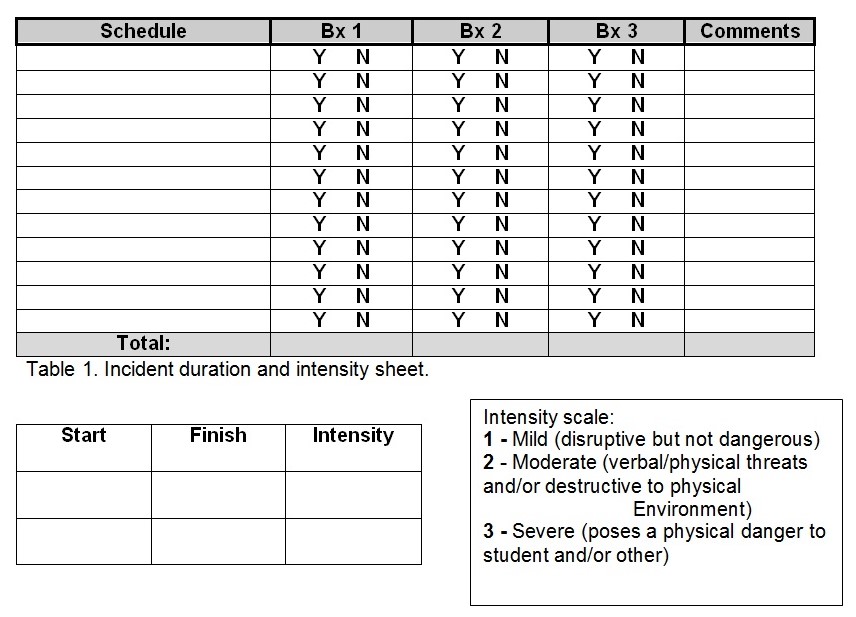
Data Collection and Graph
The observation of M.J. at school was made during one day that was divided into nine intervals in accordance with the schedule of lunches and periods (Chart 1).
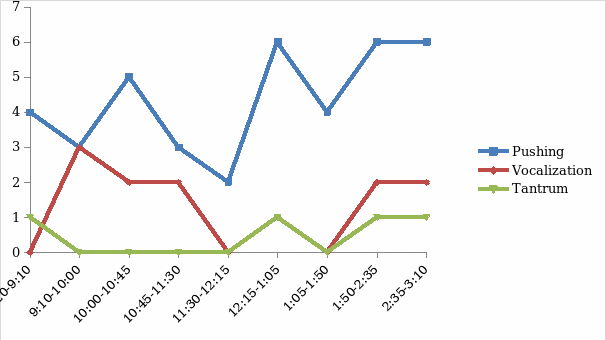
The second chart points to the total number of interfering behavior, and it is clear that pushing is the dominant disruptive behavior that needs to be correct.
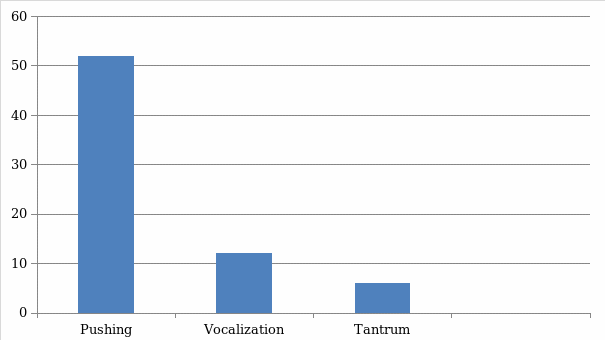
The third chart identifies the frequency with which the target behavior (pushing individual and items) is expressed during three sessions of observation at the student’s school.
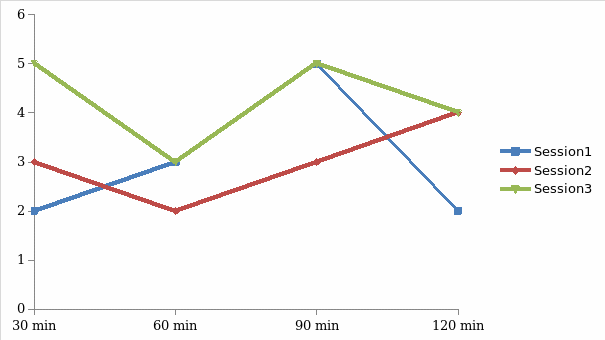
Chart 4 demonstrates the number of pushing behavior during three sessions, which helps in monitoring the dynamics of the student’s intentions to interact with peers.
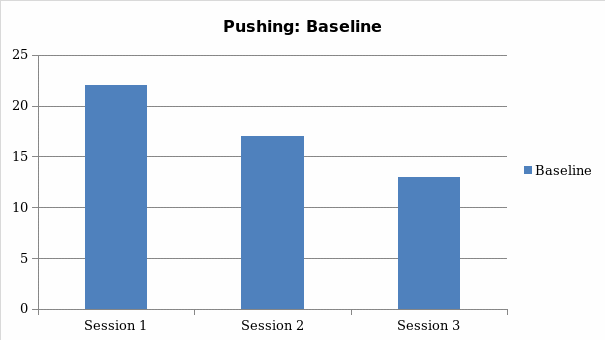
Reinforcement Evaluation and Treatment
The first step in reducing the disruptive behavior in children with autism is trying to understand the underlying reasons. In this case, it seems that M. J. uses the only way he knows to attract the attention of classmates. It is possible to suggest that auto-reinforcement values cause the target behavior of pushing items and individuals. In other words, when he used this behavior and receives the desired effect, the link between these issues appears. When the student does not achieve his goal, it may lead to tantrum and vocalization. Since pushing is the most pronounced behaviors that are practiced by M. J. and it is unacceptable in social terms, it was chosen for correction. Since children with autism can learn effectively through direct instructions, this student will be asked to slightly touch a person or the phrase “let’s play”. Considering that this student is verbal, communication skills would be developed as well. The token economy system will be used to reinforce M. J. for the target behavior. A list of items and activities that are preferred by the student will be composed in advance to prepare for the intervention.
A token will be given to the student each time he shows the expected behavior and interacts successfully with other individuals. The use of the token economy will help in establishing the connection between the reward and the positive behavior. To ensure that the intervention will be effective, the student and his mother are to be explained the foundations of this reinforcement method. The responsibility of sharing tokens will be also granted to the mother and the school staff. In a long-term period, it will be possible to extend the periods between the expected behavior and rewards, thus steadily removing them and achieving the stable results. Charts 5 and 6 illustrate data that was collected during 13 sessions at M. J.’s home and school, respectively. The results show that the intervention increased the number of the target behavior under the impact of positive reinforcement.
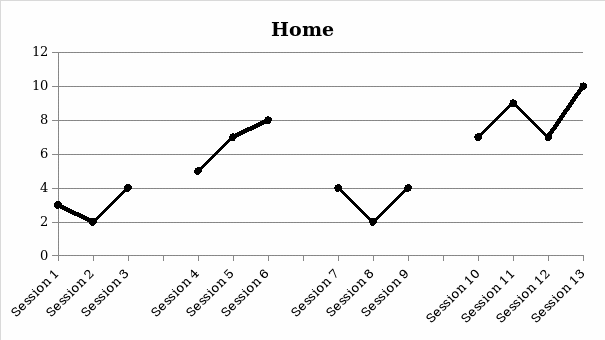
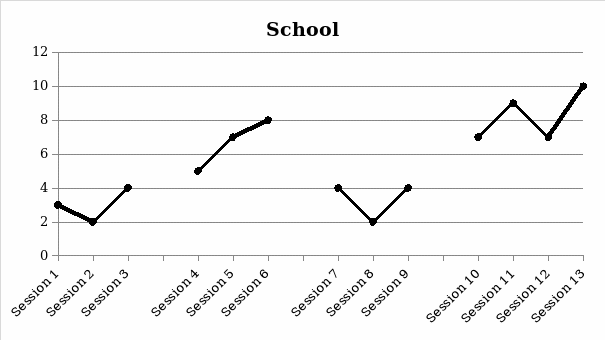
Reference
Bailey, J. S., & Burch, M. R. (2017). Research methods in applied behavior analysis (2nd ed.). New York, NY: Routledge.